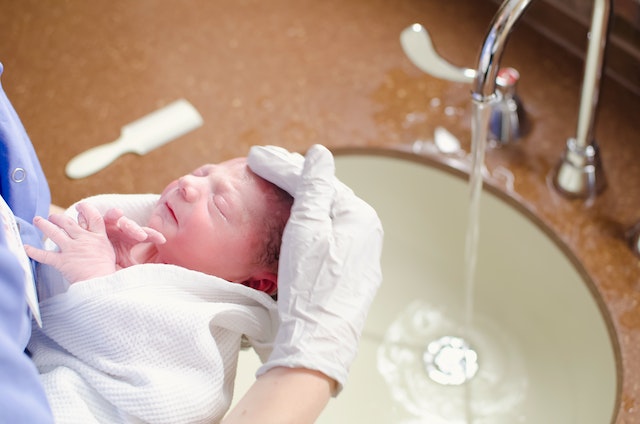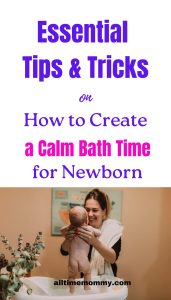How to Create a Calm Bath Time for Newborn – Essential Tips & Tricks!
Bathing a newborn can seem overwhelming, especially for a first-time mom.
While there are a lot of unknowns, it is possible to make the experience easier and more enjoyable for you and your baby.
This post highlights some tips and tricks to make bathing a newborn a breeze.
Affiliate Disclosure: As an Amazon Associate, I get a small commission for purchases made from Amazon.com through links in this post. Learn more about our affiliate disclaimer here.
How to Create a Calm Bath Time for Newborn – Essential Tips & Tricks
1. Use Evidence Based Guidelines for Newborn Bathing
According to the AWHONN neonatal bathing principles you should;
♦.Delay bathing your baby after birth
You should delay your newborn first bath until they have achieved cardiorespiratory and thermal stability.
Your baby’s thermal stability is determined by its body temperature. As such, AWHONN recommends delaying the first bath until the baby’s temperature is ≥36.8° on two consecutive measurements.
Ideally, you should realize this thermal stability when the baby is about 6 and 24 hours old.
♦.Sponge bath or tub bathing, which is recommended?
Ironically, the 2001 infant bathing guidelines produced by the Women’s Health, Obstetric, and Neonatal Nurses (AWHONN) Association in conjunction with the National Association of Neonatal Nurses (NANN) found no differences in cord healing, bacterial colonization of the cord, or cord infection between tub bathing and sponge bathing for healthy babies.
As such, the association recommends the following bathing techniques to reduce stress and prevent heat loss in a newborn.
• Immersion (tub) bathing
• Swaddled (tub) bathing to reduce stress).
• Sponge bathing
♦.Check the water temperatures.
Use warm water and a minimal pH-neutral cleanser in your bathing sessions.
Baby bath water temperature should range from 38°C to less than 40°C (100°F to less than 104°F).
To achieve an ideal water temperature, use a bathing thermometer for accuracy.
♦.Leave vernix intact as much as possible.
Leave vernix on the your newborn skin for at least 6 hours. Vernix caseosa is a whitish naturally biofilm covering the skin of the newborn.
Removal of vernix is not recommended as the coating helps in acid mantle formation to protect your baby skin from drying. It also consists thermoregulatory, moisturizing, antioxidant, and antimicrobial properties.
♦.Keep bath time as short as possible.
Limit your bath times in the first few weeks to about 5 to 10 minutes unless otherwise advised by a pediatrician.
♦.Use appropriate rewarming measures after bathing.
Skin-to-skin contact after a bath promotes bonding between a mother and the infant. Also it helps to regulate your baby’s heart rate and breathing, for better adaption to life outside the womb. Be sure to dress your baby warmly or swaddle to prevent cold stress.
♦.Establish a routine
According to AWHONN, daily bathing is not suitable for your baby. Water interaction with the stratum corneum may make the skin drier.
Also daily use of baby cleansers and moisturizers may delay the natural skin barrier maturation.
As such, you can decide to bathe your baby about three days a week.
Also be tactical about the timing.
You may choose to have a morning or evening baths.
While morning baths are essential for activating your baby’s mood, Evening baths may help calm the infant, and improve their sleep at night.
Choose what works for you!
Additionally,
Shampoo your baby’s hair once or twice a week by massaging the entire scalp gently. Be sure to use a shampoos that meet the safety requirements of a baby wash and should not cause eye irritation.
2. Invest in Essential Baby Bathing Supplies
Are you feeling overwhelmed by bathing a newborn?
Maybe you’re unsure how to hold the little human being, or you’re afraid they may fall in water tubs.
If this is you, don’t worry.
Gone are the days when moms had to struggle with baby baths.
Why?
Because we have a variety of essentials that make bath time stress frees.
Have a close look at these ones.
Set up a safe bath station
A bath station ensures that all your bathing essentials are assembled in one place. This allows you to keep one hand on the baby at all times for safety when you’re bathing them.
Also, you don’t have to leave your baby unattended in search of a particular item.
Have an excellent changing table with stability for maximum baby safety. Changing tables with raised guardrails or edges can help prevent your baby from rolling over. Also, they come with an additional compartment for storing bathing essentials.
If you’re a mama who dislikes bending over to undress or dress your baby before and after a bath, these charging stations will be ideal.
Depending on your preference, you can go for a permanent or portable changing table.
Additionally, you can choose a floor-type changing station if you’re comfortable sitting down or bending.
Be sure to add a thick waterproof changing pad liner to guard against unexpected poop or urine from staining your changing table.
Get a good baby bathing tub for stress free bathing session
Getting a good Baby bathtub should be among your top priorities that support infant safety in your home.
Baby bathtubs promote your baby’s safety during bath by reducing the risk of slippage from your hand.
They also come with a contoured headrest that allows your child’s head to remain above water level.
Most of these tubs also contain a newborn sling and a drain plug to make it easy for you to bathe your baby without worrying about slippage.
Get an age-appropriate tub like Fisher-Price Baby Bath Tub or comfort deluxe for those hard-to-manage first-year bathing sessions. Also, you can still adjust and use these tubs with your toddlers.
Add baby bath support
Since newborns can’t hold their heads up, it’s best to bathe them in a smaller tub designed to support their small bodies.
Sometimes having baby bath support is necessary for stress-free newborn bathing sessions.
I know most baby bath tubs have support measures, but some don’t incorporate these aspects.
Going an extra mile to buy a bath support like this one will help easy your work in the first six months.
If you choose to do a sink bath, incorporating sink bather like these ones or sink bathtub cushions will go a long way in enhancing your baby comfort and making bathing process super enjoyable.
Have a baby bath thermometer for temperature gauge
According to AWHONN, baby water bath temperatures should range between 38°C to less than 40°C. And there is no better way of conforming to these desirable temperatures than using a bath thermometer.
Bath sponges, brushes and wash clothes
Bath Sponges are not necessary for newborns, but as they progress, you may need one for their soft skin.
One of the benefits of using a sponge during a bath is to create a rich lather that gently cleanses the skin, helping you get rid of dirt, dead skin, and other patches on your baby.
Some parents even prefer a soft brush for cleaning and exfoliating baby dandruff or a cradle cap.
Depending on your prevailing needs;
- You can get a good soft wash cloth for sponge bathing
- You may buy a soft sponge for baby body wash
- Get a soft brush for managing your baby cradle cap
Get Tear free Organic soap for everyday use.
If your baby has no skin issues, going for an organic tear-free soap will be ideal for a stress-free bath.
Most Baby Soaps are toiler made to protect your newborn’s delicate skin by locking in the moisture to prevent dryness. They’re also sulfates, dyes, and parabens-free to protect your newborn’s skin.
Here are our top picks for baby soaps
9 Best Baby Soap and Shampoos 2023 (According to Dermatologist)
Have a Baby Bath Shampoo Rinser cup
Infants hate it when shampoo water trickles and cover their little faces. Furthermore, if bath water gets in their eyes or ears, they feel irritated.
That is why getting a rinse cup can make bath time a more pleasant experience. The good news is that you can use a normal cup or jug for this course. But if you want something that can control the water flow for a stress-free bath, then one of these will do.
Best baby bath shampoo rinsers
- Skip Hop Baby Bath Rinse Cup, Tear-free Waterfall Rinser
- Frida Baby Bath Time Rinse Cup with Easy Grip Handle
- Munchkin Duckling Bath Rinser, Yellow
Bath Kneeler and Elbow Rest Pad
A bath kneeler is for your comfort, mama. You may still have a weak back if you’re still recovering from birth chronicles.
Why don’t you get one of these kneelers to boast your comfort when bathing your young one?
They are also nonslip and can help lower the risk of slipping off during or after a bath. Unless you’re doing a sink bath, I highly recommend adding these to baby bathing essentials for distress-free life.
Here are our top picks.
Hooded Baby Towel
Newborns lose heat rapidly, as much as three times faster than adults. Their body can lose heat through the feet and head. That is why it’s essential to have a hooded baby towel to wrap in your baby after bath.
A bath towel with a hood can help keep an infant’s head warm and dry right after a bath or before getting dressed.
3.Understanding the Comfort Needs of a Newborn During Bath
There are four pillars to understanding your baby’s comfort needs, especially during baths. These includes;
Well fed baby is easy to handle
A hungry baby can be cranky, ha! They keep crying throughout the bathing session and can extend their fussiness even after a bath.
Be sure to feed your baby a few minutes earlier before bath time.
Feeding your baby at least 30 minutes before bath time prevents crying during bath sessions and lowers the risk of Spitting up and dribbling milk when bathing.
Warmth
Babies will cry when they feel cold. Make sure your bathing area is free from drafts or wind. Also, water temperature should be about 38°C to less than 40°C, the recommended temperature for baby bath water.
Affection and attention
Babies love it when they feel loved. Reinforce your baby’s security during bath sessions by looking into their eyes and conversing. These activities will promote bonding and create a more friendly environment.
4. Ideas for Distraction While Bathing Your Newborn
Most infants dislike bathing times. As such; you must come up with clever ideas to distract them for maximum enjoyment.
Here are a few tips you may consider incorporating into your bath sessions.
- use pacifiers for soothing
- Use bright bath toys for distraction
- Talk, sing and converse with your little one for engagement
10 Best Bath Toys For Toddlers 1-3 years
Takeaway
Bathing a newborn can be a daunting task. However, understanding the needs and expectations of your baby can make it a more enjoyable experience.
Now that you know the tips and tricks for a stress-free bathing experience, enjoy this extra time with your little one and use the time to bond.
UPNEXT:
- Newborn Baby’s First Bath; Here’s a Simple Step By Step Guide On How To Bathe Your Newborn
- 7 Unwritten Baby Routines That Sustained My Sanity In The First 3 Months After Birth
- 10 Best Ways To Make Bath Times Interesting For Toddlers and Pre-schoolers









